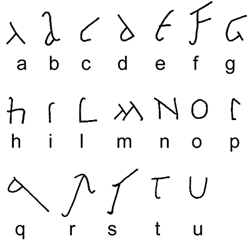
Click on the image for a larger version. |
Image
details:
Some of the commonest forms of letters in
the Vindolanda ink tablets
Image ownership:
© CSAD |
These Latin cursive hands are extremely difficult to read. Many
tablets survive only as fragments. The writing is often irretrievably
faded or abraded. Dirt and staining on the tablet surface may be
confused with traces of ink. Even where texts are well preserved
individual letter forms are difficult to differentiate from one
another, unless enough of the text survives to provide a basis for
analysis of the letter forms used by a particular writer. For example
in many texts it is impossible to distinguish the letters c
and p or a and r; in some texts s
and t are made in very much the same way. Progress in reading
the words can often be made only by trying various possibilities
until some sense emerges. This is particularly true of private letters
in which, unlike official documents, it is impossible to predict
the content on the basis of parallels with other examples.
Even Roman readers sometimes had difficulty with this script. In
a scene from Pseudolus, by the Roman playwright Plautus,
the eponymous character, the slave Pseudolus, is unimpressed by
the writing on a wax tablet sent to his master, Calidorus, by the
young man’s lover (Pseudolus 13ff: trans. Watling).
Pseudolus: All these letters, they seem to be playing
at fathers and mothers, crawling all over each other.
Calidorus: Oh, if you’re going to make a joke of
it -
Pseudolus: It would take a Sibyl to read this gibberish;
no one else could make head nor tail of it.
Calidorus: Why are you so unkind to those dear little letters,
written on that dear little tablet by that dear little hand?
Pseudolus: A chicken’s hand was it? A chicken surely
scratched these marks…
Technology can help with reading the texts, especially when the
ink is very faded or invisible to the eye. Infrared photography
has been used since the earlier 20th century to help with the reading
of papyri and is also essential for reading the Vindolanda tablets.
In the infrared spectrum the carbon-based ink absorbs light while
the wood reflects it, thus making the ink much more visible. Electronic
imaging of the tablets has allowed the photography to be taken a
stage further, using a digital scanning back mounted on a studio
camera body with an infra-red filter. The highly sensitive cells
in the scanner detect subtle differences in shade between the ink
and the wood. These differences can be digitally manipulated and
enhanced so that the ink writing stands out more clearly against
the background. High resolution scanning also allows individual
letters to be examined very close up. After capture digital images
can be further manipulated by image processing software.

Click on the image for a larger version. |
Image
details:
Traces of two or three superimposed scripts
on part of stylus tablet 725, revealed by low-angled lighting
Image ownership:
© CSAD |
The stylus tablets raise different problems. The wax has usually
perished, leaving traces of parts of characters and parts of texts
in the wood beneath. The re-use of tablets means that traces of
multiple texts (a ‘palimpsest’) must be distinguished.
A joint project between the Classics and Engineering departments
at Oxford University is developing methods
of image processing for reading stylus tablets .
Like the tablets themselves, digital images raise problems of conservation
and storage. As computer technology develops at breakneck pace,
the lifetime of digital images of the tablets risks being much shorter
than the millennia over which the tablets themselves have survived.
They must therefore be stored safely in a
format that will remain readable despite changes in software.
|